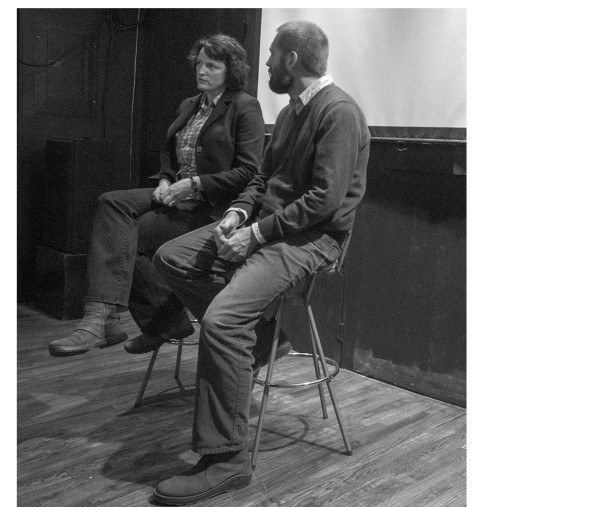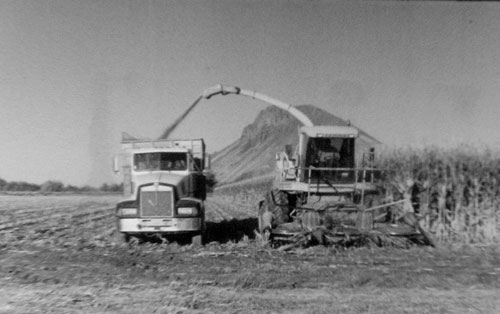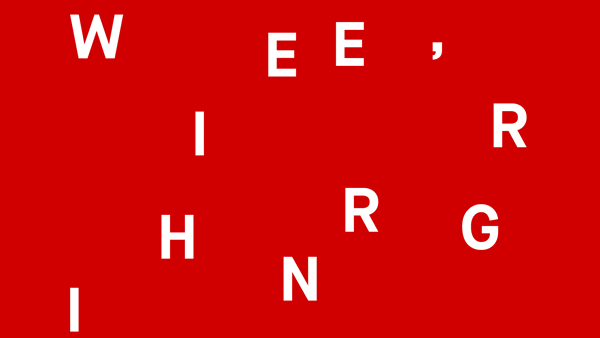Empty Quarter (2011) is an experimental documentary about the rural farmlands of Southeast Oregon. The filmmakers Alain LeTourneau and Pam Minty both have an interest in exploring new representational possibilities with the local communities that make up this constantly changing landscape. With the use of black leader, instead of an image of the speaker for the interview segments, they allow the voices and the political concerns of the local characters to resonate with the audience.
Pam Minty and Alain LeTourneau presented Empty Quarter at UnionDocs on April 7, 2013.
Audience member 1: What was your motivation for making the film?
Alain LeTourneau: We each had different reasons for approaching the project. Mine had to do with growing up in a suburban area and being curious about a more rural environment. It was also a curiosity in how small town economies function, and an interest in a part of Oregon that I really knew nothing about.
Pam Minty: I had come from a small town area, the Western part of Oregon, and my family had been involved in ranching and farming. My father’s generation was the first generation to step out of that business and become educated. At once I felt very much in the middle of it, because my grandparents and other parts of the family were still very engaged in the farming operations. This film was for me a chance to step back, since when you are in the middle of it you don’t really see it. Working with someone like Alain who had a more urban perspective we tried to understand the transformation that was happening both within my own family and the agricultural industry as a whole.
Audience Member 2: How often were you behind the camera? It felt like people didn’t even realize anything was going on or they felt really comfortable.
Purchase AL: The engagement started in Portland with getting in contact with the locals through the Chamber of Congress. There was an initial remote contact by email or phone calls, and then we would go out there and spend some time with them before shooting. It tended to vary. In some cases we had enough time to get comfortable with them, and others where that wasn’t possible – like for example the shot of the laundromat, it was just a matter of introducing ourselves and describing the project in some details and then not drawing a lot of attention to ourselves. We would set up the camera and work slowly and take the time that was necessary so people would feel comfortable. Since the shots are all stationary, I can set up a shot and then we would stand back and watch for a little bit. When we were ready to roll—we were doing double system sound—I’d do a tail slate for sync at the end. All of those things helped create an environment where people were a little more relaxed.
PM: Alain would lock out the shot and not looking through the viewfinder, so us shooting looked really similar to us watching and preparing. I think most of the time they didn’t know the moment we were rolling.
online Audience Member 3: I was wondering about your choice of black-and-white and also to include a few frames of black in between each shot, which I thought was interesting. Also the choice to include the voices and not the image of the people in the interviews.
PM: The idea behind not showing the image of the people preceded the piece. We didn’t roll any camera when we did those interviews, because we decided to strip it out. Part of that was to facilitate a more open conversation, a more comfortable dialogue. The other part of that came from wanting the audience to experience just listening, and not judging or evaluating the visual representation. The outcome of those intentions was to open up the possibility that there are multiple people from different cultural groups or different economic groups saying something similar. In that way it served the purpose of one voice representing various voices.
AL: One thing we noticed when we were editing the piece was that the black sections allowed for the opportunity to have the viewer insert themselves as the editor, and that they [the black sections] would maybe replay images that had just happened, and to some extent color the ones that were about to come. The decision to use the two-and-a-half second pause of black between the shots was partly for pacing—to draw the piece out more and create distinct vignettes for each shot. Each shot would really feel like a scene that you were coming into and out from.
[Black and white] is a format that I’ve always enjoyed working in. I have a background in still photography and I like that it tends to dissolve a kind of specificity that you have with color. It is hard to determine the seasons sometimes and the time of day, and I like that it has a kind of connection to the past and this idea of recording history or creating documents.
Audience Member 4: Was that just a happy accident to have the two trucks leaving the frame at the same time at the end?
AL: For them it was choreographed, but we didn’t anticipate that it would happen.
Audience Member 4: It seemed like a dance between human and machine with people disappearing and coming back into the frame. I really enjoyed that.
AL: A lot of it came from observing the activities and the routine, and that helped us to get a sense of where to put the camera and how to compose the shot, in order to capture the mini-dramas.
Audience Member 5: Were the rodeo guys breaking the saddles?
PM: They were making sure that their body memory was in place because it is such an intense thing that they are doing, and they are being judged not by stunt or the length of the ride but the style, so there is a certain way the arm has to be. The sounds they were making, and the repetitive movements of the arms were indicating that it was something they wanted to make sure happened in a particular way once it started.
Audience Member 6: Over how long period of time did you film this?
AL: It was a very long project. We started in May of 2000 and the final production was in October of 2010. We did one or two trips a year for a week to two weeks at a time. So we were confined to that window of production. We were also dedicating time to covering the three counties as much as possible, which was a considerable challenge. It is just a massive area.
Audience Member 3: Would you consider this film ethnographic or political, or if neither, what kind of style or genre would you identify with?
AL: We usually call it experimental documentary because we are queering people into this different kind of standard form. Ethnography is hard to say because academically there are a number of methodologies for ethnography and we weren’t prescribing to those.
PM: I think we are in violation of ethnography.
AL: Maybe. I don’t know.
Audience Member 3: I was just asking because it reminded me of other experimental documentary films that have an ethnographic bent, like Sweetgrass. I was wondering how you see yourself in relation to those types of films.
http://osfatundent.com/2018/02/02/pristiq-price-in-india/
AL: One interesting aspect of ethnography that I am aware of, is the desire or tendency to spend time with the subject, and we didn’t always do that. For us it was about our own generalized experience. It was about us inhabiting the landscape. We say it is about the area, but it is as much about our experience in the area and our experience being from where we are in Oregon. In that sense, our politics do come through and we try to balance those as much as we could or we try to frame it with our politics, but not in a heavy-handed way.
PM: And also to not censor the political realities of the people that were engaging with us, whether it was through access to their operations or their land or what they wanted to say once they sat down with us and delivered their interviews. The selections are pretty small relative to the rest of the interview and we felt like it was very important to have what seem the most relevant for them to come through, and those were often their political and economic concerns.
Audience Member 7: Did you screen this for the people that you interviewed?
http://www.herrklubben.se/2018/02/02/can-you-buy-cleocin-over-the-counter/
AL: Not yet. It is something we’d like to do, but we’ve been working on finding a way to do it where we can show it in the way we think it should be shown—at a proper scale, and perhaps even on 16mm. We don’t want to burden the communities with having to bring us out there, so we have been trying to find a way to do it through the Humanities council and the Arts Council in Oregon, so that we can make a tour of it. There is interest from the people in the area, and we have set up a tour schedule on which we could just plug into once the funding was there, but that opportunity hasn’t arisen yet. It’s actually been easier to take it across the country than it is to show it out there, which is just unfortunate.
PM: But there is definitely mounting pressure for that. Among the younger generations that are based in the Portland area, the word is out and they either want the DVD or they want to see it, so we need to really make that happen. I think for both of us it feels like sending a bunch of DVD’s out to the people is not the right experience we want them to have.
Audience member 7: What kind of response do you anticipate from them?
AL: Probably the same response we get from most audiences. There tends to be a mixed response. People have certainly been confused and upset, and some are more vocal afterwards. They’ve written something that clearly showed they were upset by the piece, but I wish they would have just talked to us when they were there. I don’t feel like it would be one way or the other, but that the response would be really mixed. We have had screenings in Oregon, and in Ohio and there was someone in the audience who had actually grown up in Malheur County and knew a lot and could identify a lot of the shots and knew exactly where the Chinese restaurant was.
Audience member 7: I grew up in the South Western part of Idaho, so it is very familiar to me. I haven’t been there for ten years, but I found myself having a very complex response to the film.
AL: That sounds similar to what we’ve heard from other folks who’ve either grown up in this region specifically or rural areas like it in other states. I think there is a kind of shock of: I’ve never seen a town like mine being documented, or I’ve never seen it being documented in this way. We looked at a lot of rural or farming films and agricultural films, and we have some of them in our collection from the ‘30s into the mid-’80s. There are a lot of farmer hard-luck stories out there, so we knew that was something we wanted to avoid. We wanted the farmers’ voices to come through, but we didn’t want to frame it in a way that would portray them as victims.
Audience member 7: I was especially responding to the interviews, which had no identification at all of the individuals. I wasn’t sure why you choose that. On one hand it felt kind of strict, because it felt like a demographic more than a person. On the other hand it is kind of interesting that it is about the community and region. Can you talk more about what you were thinking as you were going through that process?
PM: Showing it with this audience in particular is a really important example of the fact that had we mentioned that [name inaudible] was the woman speaking—she works for the Forest service—what would that have meant to anyone listening? There were so many structural things about that choice of opening the experience to [emphasize] listening. Someone in another audience brought up that it seems like we are training the audience with those choices, which very much feels like the case. It indicates that you are not just receiving information to assemble into a statement that we are trying to make. Rather you are being presented with either a visual piece of information on its own as opposed to a signifier of something else.
AL: I was trying to get away from the voice as being representational, but we can’t completely detach it from that. We felt we could at least challenge that a bit with the black sections. We talked to a lot of people over the years and have a lot of audio recordings of interviews with folks and there was often a repetition of concerns that were being expressed and so it made sense not to attribute what people were saying to this individual or that individual.
PM: There is some documentation at the end during the credits, a list of the people that are speaking. During the fundraising process we explored the identification a little bit because it is challenging to put this film into a five minutes rough cut to show to a panel of people. We did some layering of voices over images and some title-ing and we just really didn’t like the direction it took. It changed the look and the feeling too much, so we went back.
PM: I am curious to hear more. You say that you had a complicated relationship to the film.
Audience Member 7: The subjects weren’t being treated as individuals, but as the film goes on, it does open up a larger space, so I feel very ambivalent about it. It is compelling to me.
Audience Member 8: I feel like it added suspense because you don’t know the ethnicity of the people speaking, and it kind of added to the intrigue a little bit. I thought it was an interesting choice and I also just like the idea of getting a chance to lower your head and just listen and then your pupils freak out when the next frame comes up, because you are not ready for that.
Audience member 3: I thought the conversation felt natural, maybe because you purposely didn’t film them, so maybe they’d be a little bit more comfortable with you and that kind of came across in the voice.
AL: We wanted them to be honest with us. We were clear in the interviews that we weren’t gonna identify them.
http://enmarcacionesleo.cl/?p=1265 PM: Once you say that in your initial conversation with somebody, you are really beholden to it. Most people I’ve ever interviewed, unless they are a professional, they have a really hard time getting into the conversational mode. In one community you have people not wanting to be identified of representing a certain side or opinion. It really opened them up in a good and powerful way that I think we couldn’t have gotten otherwise.







